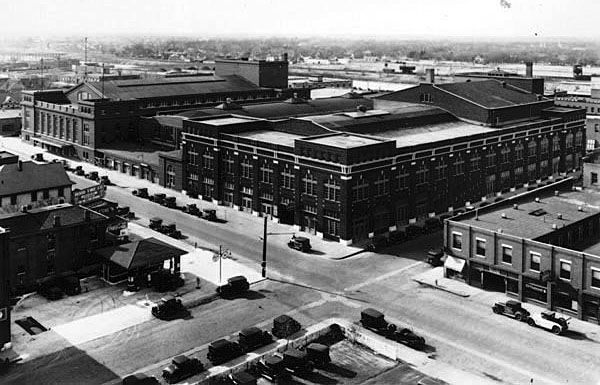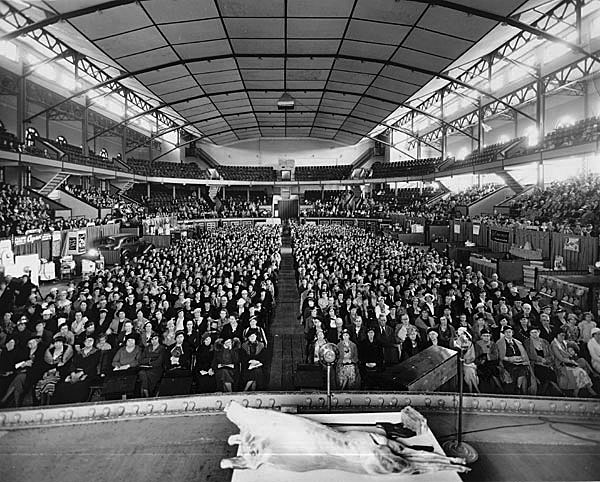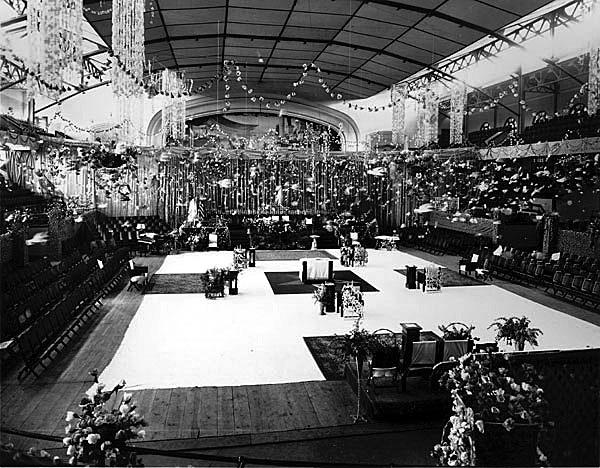WICHITARCHAEOLOGY by Michael Carmody

The Wichita Forum: Century I
Modern promoters looking to book a rock concert, lawn & garden show, bridal fair, agricultural exposition, music theater production, industrial convention, sporting event, automotive exhibition, lecture or other major attraction in Wichita have the luxury of choosing among any number of venues; Intrust Bank Arena, Century II, the Kansas Pavilions, the Cotillion Ballroom, Hartman Arena and other large-capacity halls are all in frequent use. But for over half the 20th century, the place to see all there was to see in Wichita was the Forum.
In the spring election of 1909, the citizens of Wichita approved a bond issue to pay for a public hall, and with surprising speed, the city government got the ball rolling. The storied architectural firm of Richards, McCarty and Bulford were called in from Columbus, Ohio to design the building (they had crafted the Beacon Building and would less than a decade later also draw up the plans for Wichita's Lassen Hotel) and by May 1910, Mayor C.L. Davidson— the man behind the "Watch Wichita Win" sign (see the March 7 issue of F5)— laid the cornerstone at 231 S. Water Street, in what was then known as Haymarket Square. (Incidentally, this spot was the site of the home of Wichita founding father William Greiffenstein, after whom William Street is named, apparently because "Greiffenstein" is too long for a street sign; the city moved his historic house to the intersection of Wichita & Third Streets to make room for the new auditorium.) There was some argument over a name for the venue; suggestions included Hippodrome, Wigwam and Wichitorium. Eventually the simple moniker "Wichita Forum" won the day.

Less than two years after being approved by the public, the Forum opened its doors on January 25, 1911. Five thousand people came to the dedication ceremony and were flabbergasted by the astonishing asbestos stage curtain, second largest in the nation at 63 feet wide by 37 feet tall and hand-painted with a scene depicting Ben Hur's chariot race, copied from a painting owned by plutocrat J.P. Morgan. The entertainment for the evening was a performance of “The Children’s Crusade” by the Cincinnati Symphony Orchestra, joined by a chorus of 400 local singers.
Over the years the Forum grew as additions were annexed onto the existing building, allowing greater flexibility in the types of events that could be hosted there. A municipal swimming pool was planned an adjunct to the complex, but a shortage of labor and municipal funds due to World War I put the kibosh on that in 1918. Eventually a city marketplace and an early local history museum became parts of the Forum's sprawl.
As the years passed, the facility regularly played host to all manner of world class entertainment, as well as events of local interest. Among the attractions: Classical pianist and former Polish Prime Minster Ignacy Paderewski, opera legend Madame Ernestine Schumann-Heink (on her 1928 farewell world tour), the International Wheat Show Wichita Fair and Exposition (which drew upward of 180,000 attendants at its peak), Elvis Presley, the Wichita Garden Club Flower Show, former President Theodore Roosevelt, ballet superstar Anna Pavlova, the 1936 Kansas Diamond Jubilee, numerous high school graduations, civic ceremonies and hundreds upon hundreds of other events, large and small.

By the early 1960s, the Forum was half a century old and starting to show its age. The "urban renewal" trend was changing the faces of downtowns all over the country and Wichita was no exception. As part of the city's approaching centennial celebration, plans were hatched to demolish the Forum and a series of other dilapidated buildings along the east bank of the river and replace them with a new space-age civic center to be known as Century II.
The very last performance at the Forum took place on April 4, 1965; it was a touring performance of the Grand Ole Opry, and every seat was sold. It would be four years before Century II opened its doors and became the city's new hub for entertainment. Today the entire area between the river and Main Street on the east and west and between Douglas and Lewis on the north and south has changed so radically, it is difficult for modern Wichitans to imagine how this section of downtown looked for such a very long time. The old red brick buildings of "Tractor Row," from which generations of farmers purchased their equipment, are long gone, replaced by the expanded Century II complex, A. Price Woodard Park and the luxurious Hyatt Hotel with its slick "water wall." The Forum is gone, but the area is still capable of drawing huge crowds to events such as the Starbird-Devlin Car Show, Music Theater of Wichita performances and the Wichita River Festival.